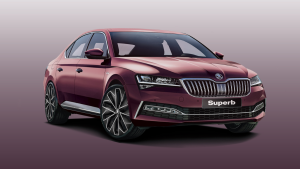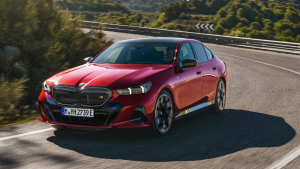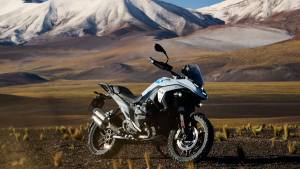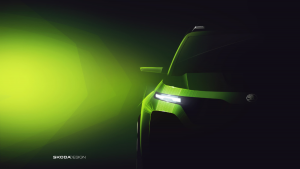BMW G 310 R debuts first motorcycle of BMW-TVS joint development project
BMW just lifted the curtains off the motorcycle it has been busy co-developing with TVS Motors, an arrangement that was announced in April 2013. The new motorcycle is called the BMW G 310 R. The motorcycle looks like a modern, aggressively styled, street naked with lots of BMW cues. BMW has not revealed the full specification and details just yet. However, they do make clear that the TVS is their Indian production partner and that BMW developed the BMW G 310 R and will play a vital role in ensuring that the Indian-made G 310 R meets the German motorcycle maker's quality standards. No launch dates yet but we expect the BMW G 310 R to make a big splash at the Milan motorcycle show (EICMA) next week. Launch and sales plans should become clearer then but we do expect the BMW G 310 R to be at the Auto Expo 2016 and the price and sales should start soon after.
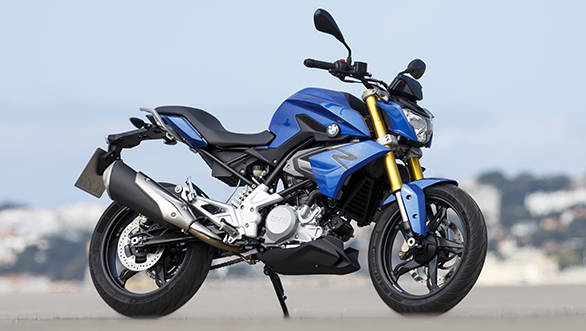 BMW developed the new G 310 R in Germany but the bike is produced by TVS Motors out of their Hosur plant
BMW developed the new G 310 R in Germany but the bike is produced by TVS Motors out of their Hosur plant
Engine and powertrain
BMW has developed an all-new engine that will power the G 310 R. As is normal for current motorcycles, we expect this engine to power other variants based off the platform as well. We guess, these are obvious, that a faired sportbike (S 310 RR or G 310 RR) and an adventure tourer (G 310 GS) would be natural. Normal product development lifecycles suggest that these will appear annually a year after BMW and TVS put the G 310 R on sale.
The engine uses an 80mm bore for its cast piston and the con-rod has a 62.1mm stroke. That achieves its 310cc displacement. In nature this should be a much calmer engine than the motorcycle it will have to contend with in India, the KTM 390 Duke. The Duke uses a much more oversquare configuration (1.48 bore-stroke ratio versus the BMW's 1.29). This is a good thing because it means that despite a power disadvantage, the G 310 R should have a calmer nature of performance that will appeal to a wider audience than the polarising KTM.
The engine's highlight is that its head is mounted backwards to convention. This places the intake in the front of the cylinder block and the exhaust at the back. This arrangement seems logical but space and packaging usually lead manufacturers to place the exhaust in front (for longer routing) and the intake at the back. BMW says it tilts the engine backwards to create space and reaps other rewards.
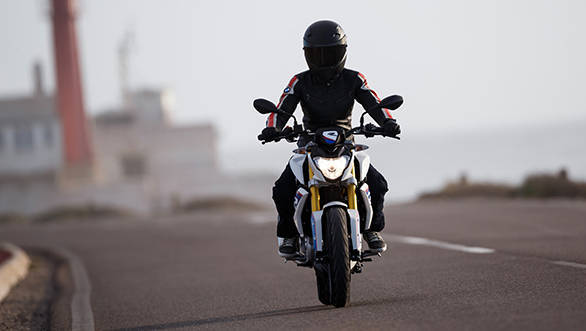 BMW promises a big bike feel despite the compact dimensions of the new G 310 R
BMW promises a big bike feel despite the compact dimensions of the new G 310 R
The G 310 R has a far more direct intake routing says BMW and it allows the fuel tank to be deep (vertically) but not very long (along the frame) which creates better front wheel loading. Center of gravity, says the company, is lower and more forward and it allows designers to create a longer than usual swingarm on a short wheelbase. BMW says this is the secret to the G 310 R's "agile handling, clear feedback from the front wheel and outstanding control." The feeling of control is critical to motorcycles in the 300-400cc space because the world over, this is new rider territory and making them feel confident is of the essence.
The engine is, of course, liquid cooled and fuel injected. Peak power is 34PS at 9.500rpm and peak torque is 28Nm at 7,500rpm. Redline is 10,500rpm. The exhaust doesn't appear to use a collector box and that shows up in the relatively large volume of the exhaust which must host the catalytic convertor as well.
BMW makes numerous references to the S 1000 RR in the technical brief on the G 310 R. For instance, the wee 310 uses diamond like carbon coating (or DLC), an extremely hard wearing surface coating with lubricative properties in the rockers in the valvetrain as well as on the gudgeon pin. The latter eliminates a plain bearing cutting reciprocating weight. The BMW also uses Nikasil, another high-end technology that offers heat dissipation benefits for the cylinder liners.
The torque from the engine heads to the 6-speed constant mesh gearbox which uses an O-ring chain to drive the rear wheel. The counterbalanced engine, says BMW, produces a very smooth powertrain and BMW adds secondary air injection to ensure that the G 310 R meets EU4 emissions.
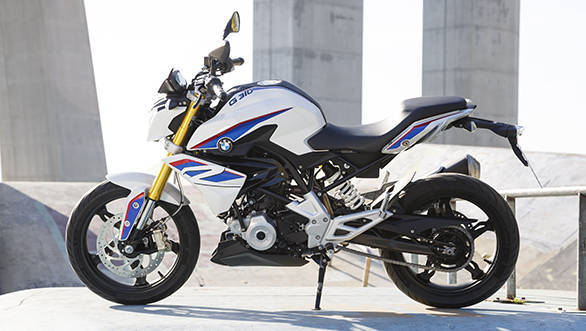 BMW G 310 R should look and feel premium thanks to detailed design work in many metal aggregates like the fork bridge and the footage subframe
BMW G 310 R should look and feel premium thanks to detailed design work in many metal aggregates like the fork bridge and the footage subframe
Chassis, brakes and tyres
As you can see, the steel trellis frame seems to be popping up left, right and center in this segment of motorcycles. The BMW G 310 R uses one as well, sticking with a cast pivot plate and offering a bolt-on rear subframe to complete the base chassis. Up front are 41mm upside down forks with no adjustability and at the back is a preload-adjustable monoshock mounted directly to the swingarm.
Using 102.33mm of trail and a rake angle of 64.9° (the Europeans measure rake as a complementary angle to the rest of the world), the front-end geometry is very similar to the KTM Duke platform. As is the wheelbase, actually, at 1,374mm. BMW says the longer than usual swingarm - 650mm - allows the chassis unprecedented neutrality while damping out forward-backward pitching and softening weight transfers. BMW says this should make for a precise, light-footed but stable ride.
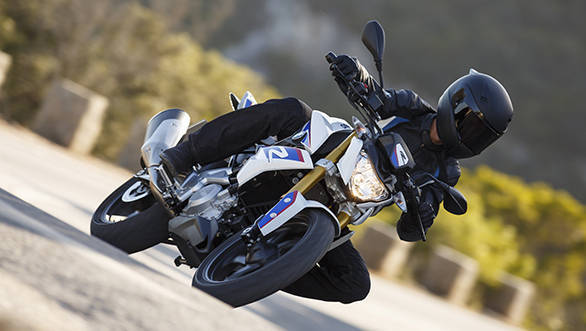 BMW say the reversed engine head configuration is part of the reason why the G 310 R will corner so well
BMW say the reversed engine head configuration is part of the reason why the G 310 R will corner so well
Is this the reason why BMW might end up offering a more supple ride than the Dukes despite having 10-15mm less suspension travel? We cannot wait to find out. BMW promises a setup that's soft enough for comfort in the regular commuting use cycle while being stiff enough for the corners as well as having enough wheel control to manage "road hole edges."
BMW uses pretty-looking 5-spoke alloy wheels wearing 110/70R17 and 150/60R17 tyres. We expect the tyres to be Michelins Pilot Street radials - these press bikes are shod with. Will these tyres come to the Indian market? Could TVS Tyres be getting ready to dazzle us with their best tyres yet?
Finally, the brakes. The 300mm front disc is joined by a 240mm unit at the back. ABS is standard on the G 310 R as are steel-braided brake lines. BMW keeps with the current trend with radially mounted calipers up front that look the business.
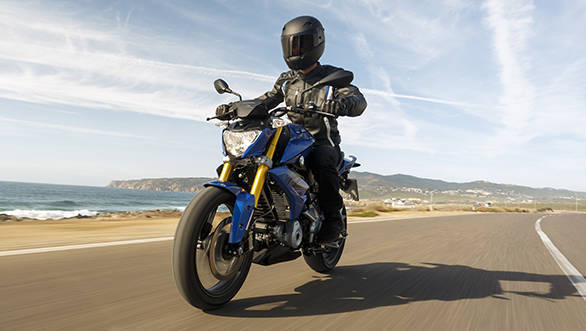 BMW Motorrad has been busy training TVS' production staff so that the Hosur production is at quality-par with its Berlin-Spandau facility
BMW Motorrad has been busy training TVS' production staff so that the Hosur production is at quality-par with its Berlin-Spandau facility
Design
The word comfortable appears repeatedly in the BMW G 130 R's press release. What that underlines is BMW's aim for the motorcycle. I believe they're aiming for an all-round comfort package that usually Honda goes for but with a slightly tighter, sportier feel. The riding shots show a rider sitting more or less fully upright with a fairly high handlebar and feet tucked slightly back. This is usually a riding posture that allows a rider to tuck and commit at the racetrack easily as well as ride upright out on a multi-hour highway run or on the commute. There is a single shot of the bike being ridden two-up which shows that the G 310 R remains a class-standard compact motorcycle that isn't going to be dramatically more spacious than the KTM Dukes.
What the BMW will be is easy to ride. Seat height is 785mm, 15mm lower than the KTM and BMW say it has a lower seat 760mm as well as a "particularly comfortable" 815mm seat on the accessories list - one hopes they will be available in India.
While we're yet to see any detail shots, BMW say the instruments use a large LCD that offers with "excellent clarity" a range of information. The full list is engine speed, road speed, total kilometres, engine temperature, fuel tank level, remaining range, fuel consumption, average speed and time.
Now to the overall design. The BMW uses a sculpted design that is extremely modern is idea and execution. That tank is definitely a shaped plastic cover over an actual plastic fuel tank inside, just like the Yamaha FZ or the KTM Duke use now. BMW says that despite the compact dimensions, the aim was always to create a large-feeling platform and that's why the wide triangulated head lamp design, a floating instrument pod above it and the fat gold forks were brought together. BMW also says the premium feel of the motorcycle comes from detailed design elements like the sculpted fork clamps and the metal work around the footpegs.
BMW is offering three colours at launch. There's a basic black bike with high contrast white, the striking all-blue scheme and a pearl metallic white with the BMW race colours as highlights that will probably have an additional price component. The blue is our favourite - the colour looks terrific against the gold forks as well as the titanium grey metal surfaces and the silver on the engine.
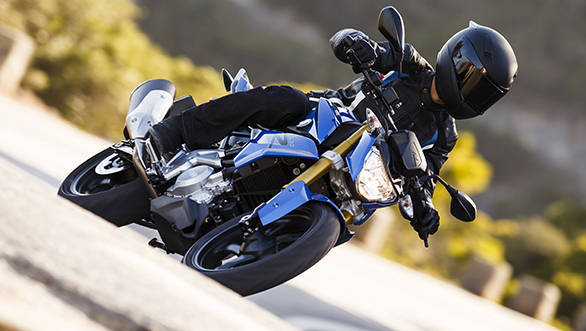 BMW claim that short wheelbase and the long swing arm combine to offer great front-end feel and neutral handling setup to the G 310 R
BMW claim that short wheelbase and the long swing arm combine to offer great front-end feel and neutral handling setup to the G 310 R
Production in India
As you know, TVS will produce the BMW motorcycles in India, at their Hosur plant indicates the release. BMW says TVS' Japanese-inspired quality processes were enlarged to meet the German maker's needs. Dedicated production and assembly areas have been created at TVS that are inspired by BMW Motorrad's Berlin-Spandau plant which is used as the basis for the G 310 R's quality standards. Engine components are created on German machines with BMW taking an "advisory role" in the quality control process. The engine assembly line features cutting-edge automation says BMW, including testing processes. After each engine is bench tested, the action moves to the new vehicle assembly area where again the latest tech is deployed to ensure German quality standards are met by each production G 310 R. BMW says the TVS staff was trained at Berlin-Spandau over the past year and the Indian production batches (the release seems to imply that production has started) meet the same quality standards as the BMW Berlin-Spandau plant.
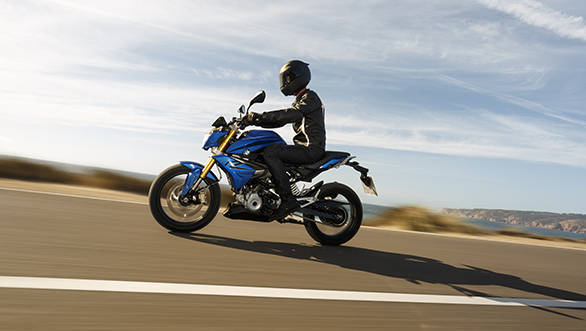 BMW underlines the upright and comfortable riding position that it has chosen for the G 310 R
BMW underlines the upright and comfortable riding position that it has chosen for the G 310 R
The competition
The BMW G 310 R enters a hotly contested segment globally. This is the playing field that was the stomping ground of the Kawasaki Ninja 250R for decades before the KTM 200 and 390 Dukes, Honda CBR300R and the Yamaha YZF-R3 entered the fray. What you should realise is that all of these bikes wear the same price, roughly 5,000, in most markets.
In India, the situation is different. The two twins, the Ninja 300 and the YZF-R3 are assembled from kits but that keeps their prices near the Rs 4 lakh mark. The Honda CBR250R gamely soldiers on but in India, the poor thing has gained a fairly sticky reputation for indifferent quality and in any case, it's performance isn't in the KTM ballpark. The orange machines from Chakan-Mattighofen are the mind space leaders in the space and their cracking performance is underlined only by their excellent pricing. BMW has chosen a displacement that sits between the two KTMs and that's clever because it abruptly halts any possibility of a direct comparison.
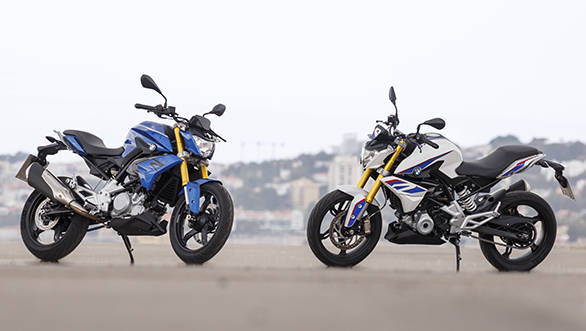 BMW announced its intention to sell its jointly developed bikes on its own in India. Expect a plan to expand its reach in India soon
BMW announced its intention to sell its jointly developed bikes on its own in India. Expect a plan to expand its reach in India soon
Overall
The BMW G 310 R is an extremely promising motorcycle on multiple counts. Firstly, the KTMs are known to be a little too highly strung to be universally popular despite their incredible value for money. The calmer, more neutral but still fast motorcycle, therefore, has been elusive - Honda's so far showed no inclination to show any respect to Indian enthusiasts by offering the new Honda CBR300R instead of the ageing CBR250R. Which is perfect for the BMW G 310 R to waltz in and stake its claim.
There are of course, two challenges. The first is distribution. BMW did announce back in April 2013 that it intended to use its own dealership network to push the joint developed motorcycle. BMW Motorrad have two arrangements - for its CBU motorcycles - using Deutche Motoren and Navnit Motors to service north and south India up to this point. BMW Motorcycles now has to expand the network in India. This is a well-understood process, though. You can get to a very large chunk of the bottom of the premium motorcycle with as little as 8-10 dealers and that's what we expect the next set of announcement from BMW Motorcycles to reveal.
Pricing in India, though, will be a harder challenge. To us, the price band is between the Rs 1.4 lakh (KTM 200 Duke, ex-Delhi) and Rs 2.4 lakh (Rs 50,000 more than the KTM 390 Duke, ex-Delhi). Anything lower would be impossible for BMW to agree to given that it has a premium image and that TVS has to have pricing leeway for their version of this platform to co-exist.
Anything higher than Rs 2.4 lakh ex-showroom and you'll run uncomfortably close to twin-cylinder options from Kawasaki, Hyosung and Yamaha.
I believe BMW will price the G 310 R in India at about Rs 25,000 higher than the KTM 390 Duke, or Rs 2.15 lakh ex-Delhi. It will mark the BMW as the premium model in the market while allowing TVS to bring their version of this platform to play just under the KTM 390 Duke. The BMW and TVS positions will both play on the fact that their product quality is better than the KTMs and Bajajs.
Let us know what you think of the bike in the comments below.
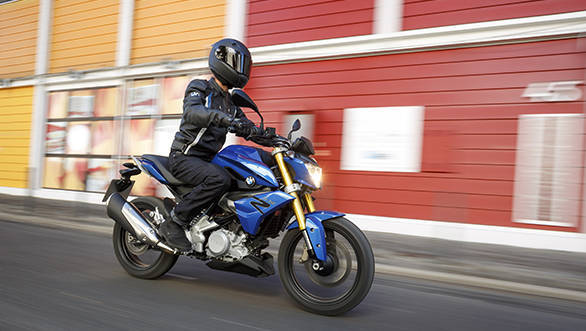 BMW promises a swift but effortless urban premium motorcycle with the G 310 R
BMW promises a swift but effortless urban premium motorcycle with the G 310 R
BASIC TECHNICAL SPECIFICATION
Engine
4v DOHC liquid-cooled fuel injected single cylinder engine
Compression
10.6:1
Max power
34PS@9,500rpm
Max torque
28Nm@7,500rpm
Geabox
6-speed constant mesh
Frame
Steel trellis, cast pivot plate and bolt on trellis subframe
Front suspension
41mm upside down telescopic fork
Rear suspension
Direct mount pre-load adjustable monoshock
Brakes
300m front, 240mm rear disc, ABS standard
Wheels
5-spoke alloy 3.0" and 4.0"x17"
Tyres
110/70R17 (F), 150/60R17 (R)
Dimensions
LWH (mm)
1988x896x785
Wheelbase
1,374mm
Seat height
785mm
Kerb weight
158.5kg
Fuel tank
11 litres
Performance
Top Speed
145kmph
Fuel economy
30.30kmpl (WMTC)
Also see BMW G 310 R image gallery
Starts Rs 2,45,000
313cc
6-Speed
34.00
28.00
30.03 Kmpl
Starts Rs 1,64,143
250cc
6-Speed
26.50
22.90
-NA-
Starts Rs 1,72,749
200cc
6-Speed
25.00
19.50
27.27 Kmpl
Starts Rs 2,52,928
373cc
6-Speed
43.50
37.00
25.00 Kmpl
Starts Rs 1,02,700
149cc
5-Speed
12.40
13.60
-NA-
Starts Rs 83,042
149cc
5-Speed
12.40
13.60
-NA-
Starts Rs 3,50,180
321cc
6-Speed
42.00
30.00
-NA-
Related Stories
Top Stories
Latest Videos
Most Popular
- Budget Sportbike Showdown: Kawasaki Ninja 500 vs Aprilia RS 457 vs Yamaha YZF-R3
- 2014 Triumph Daytona 675 vs 2024 Kawasaki ZX6R - A Decade of Evolution in Supersport Motorcycles
- Mumbai-Pune Expressway speed restrictions updated
- Nissan Magnite EZ-Shift review - is the AMT any good?
- Nitin Gadkari states that tax on Hybrids should be reduced to 12 percent in the coming future
